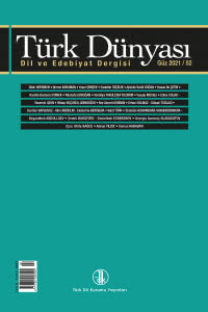Rus Asıllı Fransız Yazar Lidiya Paşkova'nın Seyahatnamelerinde Osmanlı Eyaletlerindeki Kadın ve Erkek İmajı
Lidiya Paşkova, Lübnan, Sinop, Palmira, Osmanlı İmparatorluğu, Doğu toplumu, oryantalizm.
The image of Men and Women in Ottoman Provinces in the Travelogues of the Russian-born French writer Lidia Pashkova
Lidia Pashkova, Lebanon, Sinop, Palmyra, Ottoman Empire, Eastern society, orientalism.,
___
- Вarat, C. (2009). “Les antiquités de Sinope du Pont dans les récits de voyageurs (XVIIIe-XIXe siècles)”. F. Baratte éd., L’Antiquité vue par les voyageurs, 130e congrès national des sociétés historiques et scientifiques, La Rochelle 2005, Vol. 130, No. 6, 7-16.
- Champion, R. (2021). “Gertrude Bell et ses récits de voyage en Syrie (1907) et en
- Mésopotamie (1911)”. Viatica [En ligne], n°HS2, mis à jour le: 21/01/2021, https://revues-msh.uca.fr:443/viatica/index.php?id=1051. Erişim tarihi: 20.06.2021
- Charme, G. (1883). “La politique coloniale”. Revue de Deux Mondes, Vol. 60, 49-90.
- Charme, G. (1881). “Voyage en Syrie. Impressions et souvenirs. Le Saint-SepulcrePelerins et clerges”. Revue de Deux Mondes, Vol. 45, 303 - 327.
- Clio. (2008) Histoire femmes et sociétés. № 28.
- Ekştut, S. (2012). Povsednevnaya jizn russkoy intelligentsii ot epohi Velikih reform do Serebryanogo veka. Moskva: Molodaya gvardiya.
- Figaro. (1885). Supplément littéraire du dimanche, http://gallica.bnf.fr/ark:/12148/ bpt6k2741629/f3.item.r=Pachkoff.zoom Erişim tarihi: 15.06.2021
- Hodgson, B. (2002). Les aventurières XVIIe-XIXesiècle: récits de femmes voyageuses, traduit de l’anglais par Marc Albert et Camille Gerfaut. Paris: Seuil.
- La Gazette des femmes. (1879) Nouveautés Literraires, No: 60, 5.
- Lapeyre, F. (2007). Le roman des voyageuses française. Paris: Payot.
- Lapierre, A. (2007). Elles ont conquis le monde. Les grandes aventurières 1850- 1950. Paris: Arthaud.
- Moussa, S. (2012)’’Dans L’Égypte en groupe, en couple ou en solitaire. Trois modalités du voyage au féminin au XIXe siècle (Suzanne Voilquin, Valérie de Gasparin et Lucie Duff-Gordon)’’. Voyageuses européennes au XIXe siècle. Identités, genres, codes sous la direction de F. Estelmann, S. Moussa et F. Wolfzettel, P. U. Paris-Sorbonne, 241-255.
- Pashkova, L. (1886). Frantsuzskiye i angliyskyie koloni i na Kraynem Vostoke i na Vostoke (Iz zapisok krugosvetnyj puteshestvennitsı). Odessa: Novoross Telegrafa.
- Paschkoff, L. (1888-1889). ‘‘Sinope (Asie mineure). Six mois de séjour dans l’antique capitale de Mithridate et la patrie de Diogène’’. Le Tour du Monde, Vol. 57, 401-416.
- Paschkoff, L. (1877). ‘‘Voyage à Palmyr’’. Le Tour du Monde, Vol. 6, 161 – 176.
- Photographe Paschkoff L. (J. Geiser) 1881 http://gallica.bnf.fr/services/engine/search/sru?operation=searchRetrieve&version=1.2&query=%28dc.title%20all%20%22Lydie%20 Paschkoff%20%20J.%20Geiser%22%29&suggest=1 Erişim tarihi: 01.03.2020.
- Ruscio, A. (1995). Le Credo de l’homme blanc. Regards coloniaux français XIXXX siècle. Paris: Éd. Complexe.
- Semenova, M. (2013). ‘‘Problema vospriyatiya obraza jenşinı-musulmanki na stranitsah russkoy literaturs puteshestviy vtoroy polovinı xix – naçala xxv.’’. Gramota - Istoricheskie, filosofskie, politicheskie i yuridicheskie nauki, kulturologiya i iskusstvovedenie. Voprosy teorii i praktiki, Vol. 30, No.4, 151-154.
- Tolstokorova, A. (2016). ‘‘Dama v dilijanse: jenskaya geografiçeskaya mobilnost i prostranstvennaya emansipatsiya v hudojestvennoy literature epohi moderna’’. Kultura i tekst, Vol. 27, No. 4, 133-160.
- ISSN: 1301-0077
- Yayın Aralığı: 2
- Başlangıç: 1996
- Yayıncı: Türk Dil Kurumu
Ekaterina MOİSEEVA, Alim ABİDULİN, Cumhur KAYGUSUZ
Türk ve Leh Atasözlerinde Tembellik Kavramı
Süheyl ü Nevbahâr ve Tarama Sözlüğünde Geçen Kazılu Üzerine
Begzodbek ABDULLAEV, Shohida HOSHIMOVNA SHAHOBIDDINOVA
Türkmenistan Çocuk Edebiyatı (Dönemler-Temsilcileri-Türler)
TÜRKİYE’DE ALİ ŞİR NEVÂYÎ ÇALIŞMALARI
Kazan Tatar Edebiyatında Tarihî Roman Türü Üzerine
Bağımsızlık Sonrası Çıkarılan Yasa ve Kanunlar Çerçevesinde Kırgız Türkçesinin Durumu
Dooletbek ESHEKENOV, Semih BABATÜRK
KARABAĞ AĞZI ÖZELLİKLERİNİN AZERBAYCAN DİLİNİN DİALEKTOLOJİ ATLASI’NDA GÖRÜNÜMÜ
